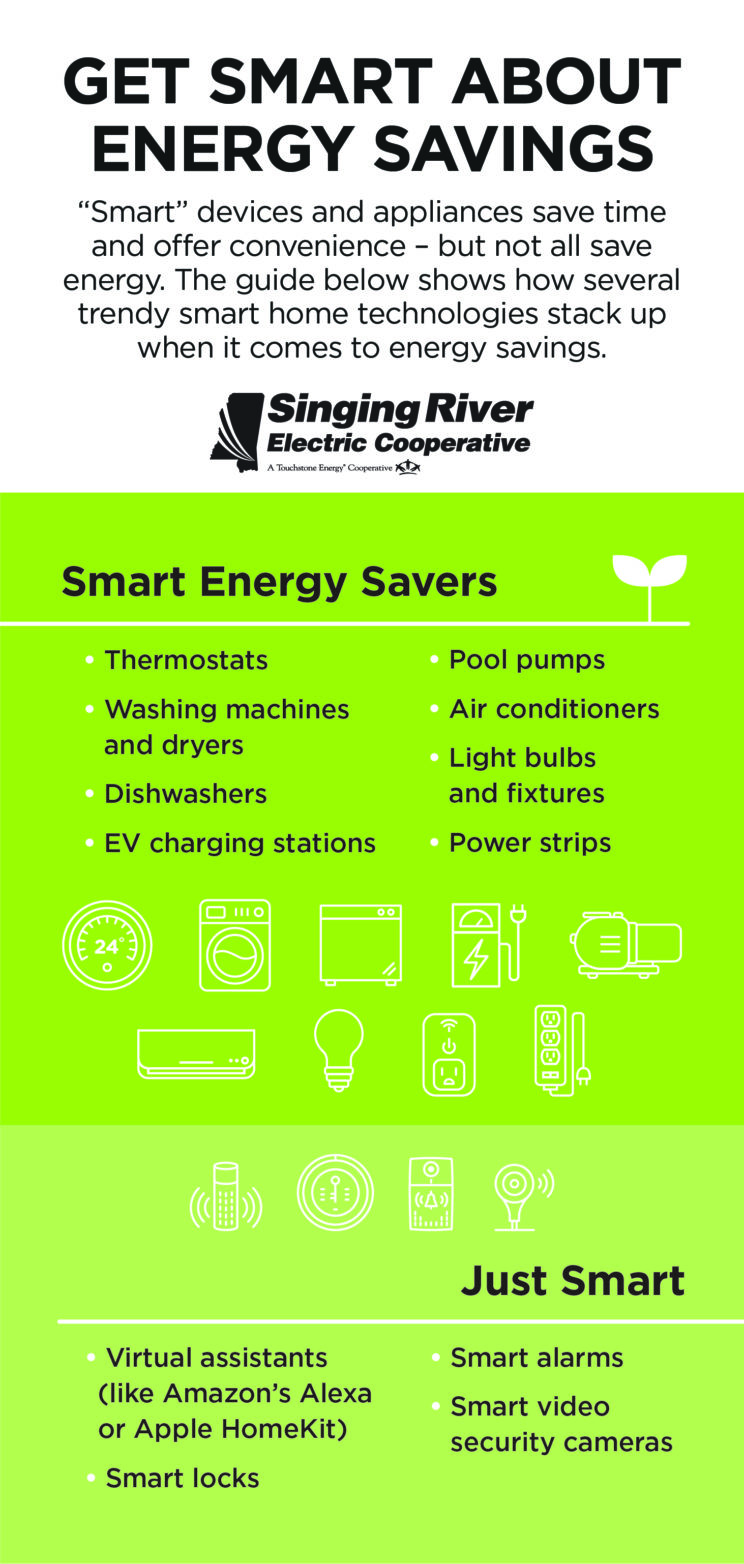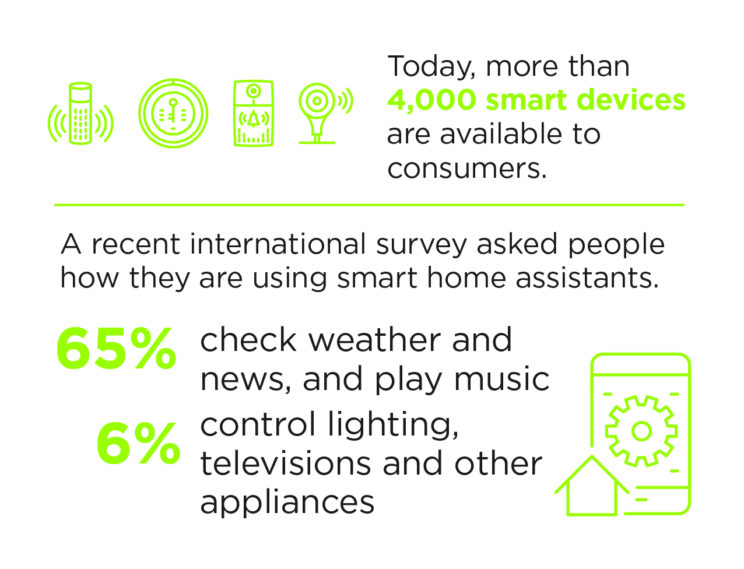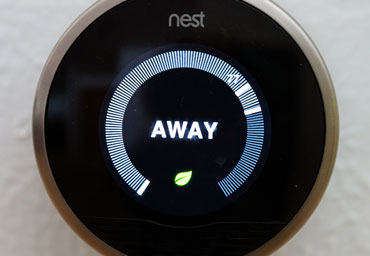 Smart devices and home automation systems are placing the powers of control in the hands of co-op members, but many questions remain about the best ways to use them to save money and energy.
Smart devices and home automation systems are placing the powers of control in the hands of co-op members, but many questions remain about the best ways to use them to save money and energy.
“Most smart home technology is about comfort and convenience. Consumers interested in saving money on monthly energy purchases should look at internet-connected thermostats first,” said Brian Sloboda, program and product line manager for the National Rural Electric Cooperative Association (NRECA).
“Around half of all thermostats sold today are smart thermostats. These devices can learn your preferences and adjust the thermostat when you are not home,” Sloboda said. “They have the potential to reduce air conditioning energy consumption by 10 percent. During winter months, the thermostats could save 7 percent on energy used to heat the home.”
Sloboda has watched home automation systems evolve over the years. He is particularly interested in identifying ways to enhance efficiency and potential savings for co-op members.
Finding Value in Energy Savings
Security system notifications and thermostat controls that adapt to home automation are among the most popular options available. But some consumers are tackling other tasks in ways that actually could help them save or manage energy use effectively.
“There are different kinds of smart when it comes to smart appliances and devices,” said Peter May-Ostendorp, principal researcher at Xergy Consulting, which specializes in emerging technologies for energy savings in buildings, including homes.
“For some, smart simply means ‘we connected this thing to the network,’ which adds minimal value to the consumer,” said May-Ostendorp, who also is an energy technology consultant to NRECA. “In other products, smart means that there is some intelligence either built into the product or connected via the cloud that enables a taste of artificial intelligence.”
But not every product using artificial intelligence is designed to save energy. In many instances, energy use is secondary to convenience or connectivity features.
Making Connections
“Most smart devices have nothing to do with energy use, grid management or other resource conservation, like saving water,” said May-Ostendorp. “Generally, the benefits—dollar savings to the consumer—have not been proven, with the exception of smart thermostats, grid-connected water heaters and similar devices.”
According to the Environmental Protection Agency (EPA), interest in connected or smart appliances is trending upward among consumers, and manufacturers are responding with a growing list of products.
“If you are thinking of purchasing a smart appliance or thermostat, look for one that is ENERGY STAR®-certified with connected functionality,” wrote EPA officials asked about the technology. “Those that meet our criteria are designed to encourage interoperability and offer the following features: low energy use, energy use reporting and consumer ownership of all data.”
Besides smart thermostats, the products available now include, room air conditioners, refrigerators and freezers, laundry equipment, light bulbs and fixtures, and power strips.
“While owning a smart product doesn’t automatically save you energy, if YOU are smart about using them, they can make a significant difference in your home,” wrote the EPA.
That means making the investment payoff could take a few lifestyle changes. But dashboards, accessible from computers or tablets, and apps available for smartphones can help.
“I don’t think many people want infinite control over dozens of appliances and systems in their homes,” said Spencer Sator, president and CEO of Crimson Consulting, another NRECA energy efficiency adviser.
“What we really want is ‘set it and forget it,’ features that we don’t have to actively manage,” said Sator. “The best devices get installed, adjusted and the consumer can walk away and still potentially save some energy.”
According to Sator, consumers are looking for simplicity. That’s feeding the popularity of virtual assistant technologies, like Amazon’s Alexa and Echo, Google Assistant and Apple HomeKit. Other companies, including Samsung, Logitech and Wink are also offering home-management hubs and platforms designed to help manage connected technology.
Convenience and programming simplicity are among the most important factors fueling consumer acceptance of what Sator describes as “home ecosystem” products. Home security controls, including locks, alarm systems and lighting are also popular features.
“We’re seeing adoption of the technology not necessarily for energy-saving reasons, but for life-enhancing applications, including some that help elderly consumers maintain independence in their homes,” Sator said.
Energy advisers agree that controlling devices from various manufacturers that perform different functions with a single system enhances the value of home automation systems.
Command and Control
 The challenges for consumers are deciding which features meet their expectations and justify the added investment in automation, and how well various products work together under management of a particular hub device or app.
The challenges for consumers are deciding which features meet their expectations and justify the added investment in automation, and how well various products work together under management of a particular hub device or app.
“This is still the Wild West, from a technology value perspective,” said Sator. “When you consider available options and actual performance of the devices available, some gadgets perform well and can save consumers money and energy, while others don’t measure up to the hype.”
With more than 900 manufacturers marketing about 4,100 connected devices, voice command technology is seen as one way to avoid collections of various remotes that typically wind up cast aside in favor of multi-function control devices.
“The Jetsons-like experience—where your Fitbit recognizes you’re awake, tells the coffee to brew, queues up your morning news on a smart speaker, ramps up the heating setpoint—isn’t really happening,” said Exergy Consulting’s May-Ostendorp. “People have thought that Alexa or Google Home might be the answer, but do we all really want to talk to our home, Star Trek style, to accomplish basic tasks?”
In fact, smart speaker technology is primarily used to answer questions, check the weather, get news updates or play music. According to a survey conducted in five major industrialized nations, including the United States, 65 percent of those asked cited those functions, while only six percent reported using the technology to control lighting, televisions or other connected devices.
“No one wants a hodge-podge of technologies that can’t communicate with each other,” said Crimson Consulting’s Sator, adding that the necessary hubs and powered interfaces to connect the devices could actually boost overall energy use. “The technology isn’t very smart if devices can’t work together.”
Derrill Holly writes on consumer and cooperative affairs for the National Rural Electric Cooperative Association, the national trade association representing more than 900 local electric cooperatives. From growing suburbs to remote farming communities, electric co-ops serve as engines of economic development for 42 million Americans across 56 percent of the nation’s landscape.


